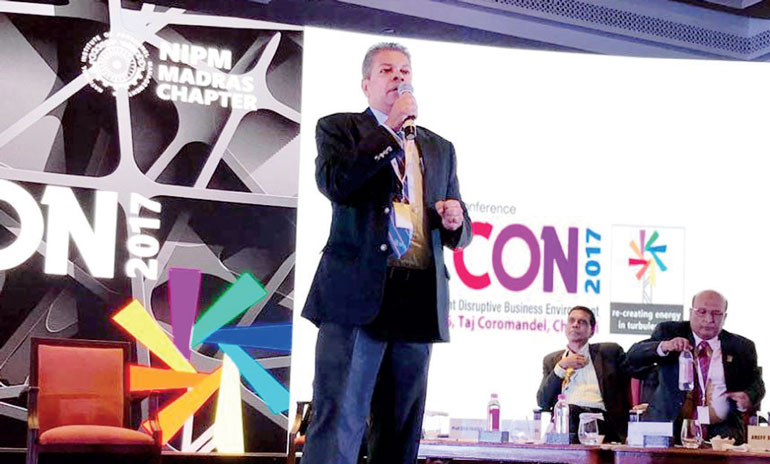Thursday Jan 08, 2026
Thursday Jan 08, 2026
Monday, 18 September 2017 00:08 - - {{hitsCtrl.values.hits}}
 I had yet another memorable visit to Tamilnadu. For the second time, I was invited to be one of the speakers at the Annual Conference of the National Institute of Personnel Management (NIPM), India. I received much warmth of Chennai people. Representing the Institute of Personnel Management (IPM) Sri Lanka, a rare opportunity of being a Sri Lankan speaker at an NIPM event held in the heart of Tamilnadu was indeed significant, in keeping the Sri Lankan flag high. Today’s column is all about the essence of what I have experienced.
I had yet another memorable visit to Tamilnadu. For the second time, I was invited to be one of the speakers at the Annual Conference of the National Institute of Personnel Management (NIPM), India. I received much warmth of Chennai people. Representing the Institute of Personnel Management (IPM) Sri Lanka, a rare opportunity of being a Sri Lankan speaker at an NIPM event held in the heart of Tamilnadu was indeed significant, in keeping the Sri Lankan flag high. Today’s column is all about the essence of what I have experienced.
Overview
IPM Sri Lanka and NIPM India have an exchange program in sending delegates to the annual conferences of each  other. Accordingly, eight Sri Lankans joined me as participants for NATCON 2017 held in Chennai. Headquartered in Kolkata, the National Institute of Personnel Management (NIPM) is a pan-India, think tank of Human Resource Managers drawn from diverse fields and industries. As one of the oldest professional bodies operating in this space for the past six decades, NIPM has been hugely successful in driving major policy changes and pushing reforms in Labour Welfare and Industrial Relations both in public and private.
other. Accordingly, eight Sri Lankans joined me as participants for NATCON 2017 held in Chennai. Headquartered in Kolkata, the National Institute of Personnel Management (NIPM) is a pan-India, think tank of Human Resource Managers drawn from diverse fields and industries. As one of the oldest professional bodies operating in this space for the past six decades, NIPM has been hugely successful in driving major policy changes and pushing reforms in Labour Welfare and Industrial Relations both in public and private.
The theme they have selected this year was ‘HR Positioning in the Current Disruptive Environment’. As the conference chair described, “In today’s disruptive business and social environment, organisations need to respond and manage, and it is here that HR leadership can strategise and harness the innate potential that dwells in the human nature.”
As one of the sub- themes associated with the conference, employee engagement in a disruptive environment received much attention. It gave me the opportunity to share the global and local aspects of the fascinating concept of employee engagement.
Essence of employee engagement
Employee engagement has become a buzz word in management circles, mainly due to its attractiveness as a tool in getting work done. What do we mean by employee engagement? Interestingly, it means different things to different people. According to research by Macey and Schneider, the meaning of employee engagement is ambiguous among both academic researchers and among practitioners. It captures the essence of employees’ head, hands and heart involvement in work. It refers to employee’s psychological state (e.g. one’s identification with the organisation), his/her disposition (e.g. one’s positive feeling towards the organisation) and performance (e.g. one’s level of discretionary effort). In brief, it captures affective (feeling), cognitive (thinking) and behavioural (acting) dimensions of an employee.
There are overlapping aspects captured in the concept of employee engagement such as psychological contract (unwritten expectations concerning the relationship between an employee and an employer) and commitment (identification and involvement with an organisation). Hence, it can be more treated as an umbrella term encompassing many related concepts. It deals with specific human behaviours that were in existence for a long period of time, with a renewed focus. In essence, as some critiques call it, employee engagement can also be perceived as “old wine in new bottle”. If it is the case, one may ask why we should focus on it. The global tends reveal the timely need of it and vital deeds associated with it.
What could be the status of employee engagement in the global arena? This has been one of the most surveyed managerial aspects in the recent past. According to a most recent study by Aon – Hewitt, “There had been a slight drop of overall employee engagement at global level compared to the previous year. According to their report, “populist movements like those seen in the United Kingdom, the United States, and those taking hold in parts of Continental Europe havemade discussions about erecting “the borders and walls more common”. As the report further observes, “these moves, if realised, will restrict the flow of labour between countries and change the economic rules of the game.”
Engagement and disruption
Disruptive technologies drive digital initiatives in diverse fields. As we discussed in my previous column, the people-centric function of Human Resource Management (HRM) cannot escape from this wave of disruption. On one side, HR professionals need strategies to “glue” their talent. On the other side, they have to face the realities of disruption when respective organisations go through massive change. How can we reconcile these two sides? It is in fact a rafting game.
We have moved from a “rowing” world to a “rafting” world. Why do I say so, unlike in rowing, rafting is much riskier. It invites you to wear a life jacket and to be vigilant in passing through sharp stones with abundance of turbulences”. Instead of following a uniform set of instructions, you need to take on-the-spot decisions based on the situational realties. In essence, one needs to be fast, focused and flexible in a “rafting” world.
We can meaningfully adapt what Seijts and Crim, two researchers of organisational behaviour termed as “ten Cs for employee engagement”, in the context of a disruptive environment. The key focus in each C can further be expanded into possible initiatives. Let’s discuss the details with local realities in mind.
1. Connect
Leaders must show that they value employees. This can be done by maintaining open channels so that employees can approach their superiors to discuss matters in a mutually beneficial manner. Disconnect leads to disengagement, with dire consequences.
2. Career
Leaders should provide challenging and meaningful work with opportunities for career advancement. They should show employees the way forward in terms of career advancements and options, in motivating them to perform in exceeding expectations. As one leading multinational claim, “we do not offer jobs, but careers, the careers that brand them for life”.
3. Clarity
Leaders must communicate a clear set of strategic priorities among the employees, in ensuring that they are clear about why they are doing what they do. It reminds me of the famous story of how President Kennedy went to NASA complex, during the peak of moon mission in late sixties. He saw a minor worker sweeping the floor, and had asked her as to what she was doing. Her response was stunning. “I am helping to send a man to the moon”. This is indeed a classic case of connecting to the organisation vision with clarity.
4. Convey
Leaders should clarify their expectations about employees and provide feedback on their functioning in the organisation.
This involves ensuring proper conduct of the performance appraisals by training the managers as to how to give constructive feedback objectively. As the communication gurus advocate, what matters more is how you say than what you say.
5. Congratulate
Leaders give recognition to others. Exceptional leaders do so a lot. Appreciating of good performance of employees by reward and recognition, in a timely fashion is something essential. Gone are the days of “employee of the year” or “employee of the quarter” or even “employee of the month”. What matters is giving due recognition to the “employee of the moment”.
6. Contribute
Leaders should make sure that employees know how their contribution matters. This can be done by introducing a transparent mechanism of objective setting and then connecting individual objectives to broad organisational objectives. Tested and proven mechanisms such as Balanced Scorecard can be handy in this respect.
7. Control
Leaders need to set the boundaries with the buy-in of the employees. This involves setting the boundaries of activities with proper systems in place with the involvement of employees, so that they are a part of the decision making process. Modern day control is more viewed as a way of ensuring consistency through conformance, as opposed to coercive courses of action.
8. Collaborate
Great leaders are team builders. They create an environment that fosters trust and collaboration. By doing so, they ensure that teamwork is given due prominence with associated mechanisms such as team-based rewards to strengthen it.
9. Credibility
Leaders should strive to maintain organisational reputation and demonstrate high ethical standards. They should demonstrate being ethical in decision making, so that employees will strengthen their admiration of the organisation. Credibility can be compared to a glass tumbler. Once it is cracked, it is irreparable.
10. Confidence
Good leaders help create confidence in a company by being exemplars of high performance standards. It involves practicing “walking the talk” at all levels so that employees have better trust and confidence on their superiors. That has far reaching consequences, including better relationships and higher results.
The ten Cs discussed above should be appropriately blended with organisational priorities, with sound HR practices in place. Once all Cs are taken seriously and put into place, the organisation is well geared to move forward in the path to progress.
Way forward
NATCON 2017 was a significant thought sharing event on disruption and its associated implications to HR. Employee engagement should by no means confine the employees to the workplace, depriving them of their family and social obligations. In research literature, higher job security, increased social support and the existence of family friendly policies have been shown to reduce the incidence of work-family conflict. Whilst striving for employee engagement, ensuring a proper balancing of other aspects needs careful consideration.
(The writer can be reached through [email protected], [email protected] or www.ajanthadharmasiri.info.)